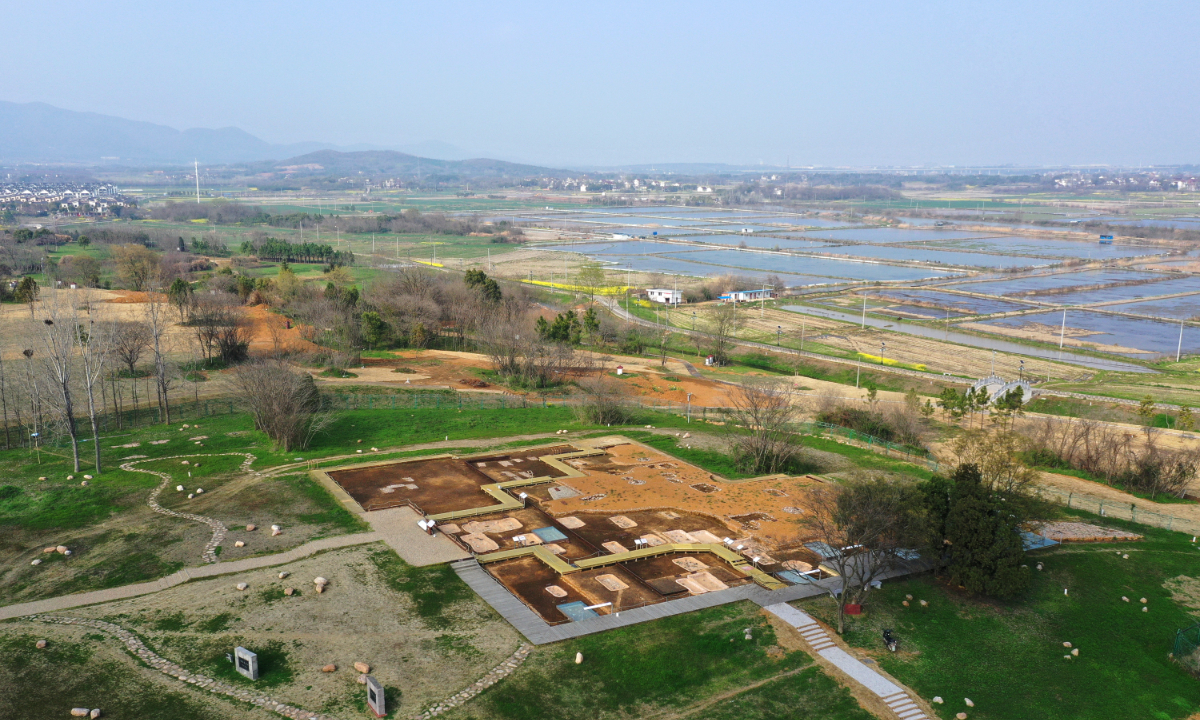A Traveler’s Guide to Lingjiatan Site: Discovering China’s Archaeological Marvel

An Essential Guide to Visiting Lingjiatan Site
Nestled within the picturesque landscapes of Anhui Province, the Lingjiatan Site (凌家滩遗址) serves as a fascinating portal into the heart of ancient Chinese civilization. As one of the most significant archaeological discoveries made in the late 20th century, this site offers international travelers a unique opportunity to delve into the Neolithic past, dating back approximately 5,800 to 5,300 years. Surrounded by the serene Taihu Mountain to the north and the gentle flow of the Yuxi River to the south, Lingjiatan is not just a relic of history but a vibrant testament to the early cultural practices and artistic expressions that shaped the region.
Discovered in 1987, the site has since unveiled a wealth of artifacts, including over 2,200 cultural relics, many of which are now housed in prestigious institutions like the Palace Museum. The relics, particularly the exquisite jade pieces, highlight the sophisticated craftsmanship and deep spiritual beliefs of the ancient inhabitants. The site is also recognized as one of the top ten archaeological discoveries in China, solidifying its status as a must-visit for anyone keen on understanding the roots of Chinese civilization.
Visitors to Lingjiatan can explore a sprawling area of more than 2.2 million square meters, where remnants of ancient structures, tombs, and ceremonial altars tell stories of a time long past. The site is open year-round, providing a welcoming space for historians, archaeologists, and curious travelers alike to engage with the profound legacy of Chinese heritage. Whether you’re wandering through the remains of the ancient settlement or marveling at the artistry of crafted jade artifacts, a visit to the Lingjiatan Site promises to be an enlightening journey through time, revealing the rich tapestry of human history that continues to influence modern China today.
In This Guide
- An Essential Guide to Visiting Lingjiatan Site
- The Rich History and Legends of Lingjiatan Site
- Main Highlights: What You Absolutely Can’t Miss
- Planning Your Visit: A Practical Guide
- Tickets: Prices, Booking, and Tips
- How to Get There: A Complete Transportation Guide
- Local Cuisine and Accommodation Nearby
- Frequently Asked Questions
- Final Thoughts on Your Trip
The Rich History and Legends of Lingjiatan Site
Nestled in the picturesque surroundings of Anhui Province, the Lingjiatan Site is a treasure trove of history that offers a fascinating glimpse into the late Neolithic period of China, dating back approximately 5,800 to 5,300 years. This archaeological wonder, sprawling over 2.2 million square meters, is often regarded as a central settlement site of its time, and has since become a pivotal point in understanding the origins of Chinese civilization.
The discovery of the Lingjiatan site in 1987 unveiled an intricate network of ancient human activity, including an altar, 68 tombs, and various structures that hint at a complex society. Among the many artifacts unearthed—over 2,200 in total—are exquisite examples of jade and stoneware, with more than 1,100 items classified as precious cultural relics. Notably, many of these artifacts, including jade turtles, plates, and spoons, now find their home in the esteemed Palace Museum, showcasing the artistry and craftsmanship of ancient civilizations.
The site has not only garnered attention for its rich archaeological findings but has also been celebrated for its cultural significance. In 1998, it was recognized as one of China’s top ten archaeological discoveries, a testament to its importance in the annals of history. Over the years, Lingjiatan has been meticulously preserved and studied, leading to its designation as a national key cultural relic protection unit in 2001. The ongoing efforts to safeguard and promote this site have included its inclusion in multiple major site protection plans initiated by the Chinese government.
Lingjiatan’s historical significance extends beyond its relics. It is recognized as a defining example of the unique cultural practices that emerged in the Yangtze River Basin, contributing to what is now known as the Lingjiatan Culture. This culture is often cited alongside other major prehistoric jade culture centers, namely the Hongshan Culture in Liaoning and the Liangzhu Culture in Zhejiang. Collectively, these cultures have played a vital role in shaping the narrative of Chinese civilization.
In contemporary discussions regarding the origins of Chinese civilization, the Lingjiatan site holds a symbolic status. It offers invaluable insights into the social structures, belief systems, and daily lives of its ancient inhabitants, providing a physical representation of a civilization that laid the groundwork for the rich tapestry of modern China. Scholars often reference Lingjiatan in studies exploring the continuity and evolution of cultural practices over millennia.
Today, the Lingjiatan National Archaeological Site Park stands as a testament to the site’s enduring legacy. This expansive park aims to educate the public about the significance of the findings while also preserving the site for future generations. With a planned area of 3.35 km² and a variety of facilities for research, recreation, and cultural education, the park invites visitors to engage with history in a multifaceted way.
For international travelers seeking to delve into the depths of China’s ancient past, Lingjiatan offers not only a journey through time but also an invitation to explore the legends and stories that have shaped one of the world’s oldest continuous civilizations. Whether you are an avid history buff or simply curious about the roots of culture, the Lingjiatan site promises an enriching experience steeped in the echoes of a remarkable legacy.

Lingjiatan Site.
Main Highlights: What You Absolutely Can’t Miss
The Lingjiatan Ancient Culture Site is a treasure trove of history located in Tongzha Town, Hanshan County, Anhui Province, China. This archaeological wonder takes you back to the late Neolithic period, approximately 5,800 to 5,300 years ago. When you visit, here are the key highlights you absolutely cannot miss:
The Vast Excavation Area
Spanning over 2.2 million square meters, the site showcases a rich tapestry of human activity from ancient times. As you walk through the area, take in the scale of this ancient settlement, which has revealed significant artifacts and cultural relics since its excavation began in 1987.
Fascinating Artifacts
The site has yielded more than 2,200 cultural relics, with over 1,100 considered precious. Among these are exquisite jade items such as turtles, plates, figures, and spoons, many of which are now housed in the Palace Museum. Be sure to look for the unique pottery and stoneware that tell the story of the craftsmanship of the era.
The Altar and Tombs
A standout feature of the Lingjiatan site is the ancient altar, which serves as a significant landmark for understanding the ritualistic practices of the time. Additionally, the discovery of 68 tombs provides a window into the burial customs and social structures of early Chinese civilization. These elements offer profound insights into the spiritual and everyday lives of the people who lived here.
Circular Ditches and Pottery Well
The site features two circular ditches, likely used for both defensive and ceremonial purposes, and a pottery well that showcases the technological advancements of the Neolithic people. These structures are essential for understanding the community’s layout and the interconnections between various societal functions.
Recognition and Cultural Importance
Lingjiatan is not merely a historical site; it has been recognized as one of the top ten archaeological discoveries in China. It has been designated as a national key cultural relic protection unit and is part of the major site protection plans for the nation. This recognition underscores its importance in the study of Chinese civilization and its unique cultural heritage.
The Lingjiatan National Archaeological Site Park
The site is part of a larger national archaeological park that aims to protect and display these significant findings. With a planned area of 3.35 square kilometers, the park will feature various projects focused on showcasing ancient Chinese jade culture and exploring the origins of civilization in the region. While visiting, you can also enjoy the integrated facilities that blend archaeological research, ecological recreation, and cultural education.
Enriching Visitor Experience
The site is open year-round, allowing visitors to explore the rich history and culture at their own pace. Spend at least an hour here to fully appreciate the depth of the artifacts and the stories they tell, making it a worthwhile stop on your journey through China.
Whether you are a history buff, an archaeology enthusiast, or simply curious about ancient cultures, the Lingjiatan Ancient Culture Site promises an engaging and enlightening experience. Don’t miss the chance to walk through the remnants of a civilization that played a crucial role in the formation of Chinese heritage!

Lingjiatan Site.
Planning Your Visit: A Practical Guide
Visiting the Lingjiatan Ancient Culture Site offers a unique opportunity to immerse yourself in the rich tapestry of early Chinese civilization. Nestled in the scenic Tongzha Town of Hanshan County, Anhui Province, this archaeological site is a testament to a time that dates back 5,800 to 5,300 years. Here’s everything you need to know to plan your visit.
Getting There
The Lingjiatan site is conveniently located near major urban centers, making it accessible for international travelers. The nearest major city is Ma’anshan, which is well-connected by public transport. You can reach the site by bus or taxi from Ma’anshan, and it is advisable to check local transport schedules for the most efficient route.
Opening Hours
The site is open year-round, 24/7, allowing you to visit at your convenience. While it’s always accessible, consider visiting during daylight hours to fully appreciate the picturesque surroundings and the intricate details of the archaeological features.
Ticket Information
As of 2025, the entry to the Lingjiatan Ancient Culture Site is free, allowing you to explore this historical gem without any financial barriers. However, it’s a good idea to check for any updates or temporary exhibitions that may require a ticket in advance.
Recommended Duration
Plan to spend about 1 hour exploring the site. This should give you ample time to take in the stunning landscape, view the key archaeological findings, and reflect on the significance of this ancient settlement.
Highlights of the Visit
-
Archaeological Features: Explore the remnants of the altar, tombs, and circular ditches that tell the story of the Neolithic inhabitants. Don’t miss the pottery well and the large red-baked earth block ruins.
-
Cultural Relics: Over 2,200 cultural relics have been unearthed from this site, including exquisite jade and stoneware. Some of these artifacts are housed in prestigious locations like the Palace Museum in Beijing.
-
Lingjiatan Culture: Learn about the unique cultural significance of the site, recognized as one of the three major prehistoric jade culture centers in China. The site helps narrate the origins of Chinese civilization, offering insight into the social practices of ancient communities.
Facilities and Amenities
While the site is primarily an outdoor archaeological park, it is advisable to bring essentials such as water, sunscreen, and comfortable walking shoes. There may not be extensive visitor facilities, so prepare accordingly.
Visitor Tips
- Photography: Capture the beauty of the site, but be mindful of any restrictions regarding photography in certain areas.
- Guided Tours: If available, consider joining a guided tour for deeper insights into the historical context and archaeological significance of your surroundings.
- Language: While some information may be available in English, it can be helpful to have a translation app or guide to enhance your understanding of the site’s rich history.
Local Attractions
After visiting the site, consider exploring nearby attractions such as Taihu Mountain, known for its picturesque views and hiking trails. The Yuxi River also offers scenic spots for relaxation and exploration.
Conclusion
As you plan your visit to the Lingjiatan Ancient Culture Site, prepare to step back in time and engage with the roots of Chinese civilization. This destination not only showcases the archaeological wonders of the Neolithic era but also invites you to reflect on the cultural significance that has shaped modern China. Enjoy your journey through history!

Lingjiatan Site.
Tickets: Prices, Booking, and Tips
When planning your visit to the Lingjiatan Ancient Culture Site, it’s important to know about ticket prices, booking options, and helpful tips for an enriching experience.
Ticket Information
The Lingjiatan Ancient Culture Site is open year-round, allowing visitors to explore its extensive archaeological wonders at any time. Here are some key details regarding ticket prices:
- Admission Fee: The entrance fee is quite reasonable, generally ranging around ¥30 (approximately $4.50 USD) per person. This fee grants you access to the main site and its various attractions.
- Discounts: Be sure to check if any discounts are available for students, seniors, or groups, as these can significantly reduce your overall costs.
Booking Tickets
Purchasing tickets is straightforward and can be done through several methods:
- On-site Purchase: You can buy tickets directly at the entrance of the site. Given the site’s popularity, especially during weekends and holidays, it may be wise to arrive early to avoid long queues.
- Online Booking: For added convenience, consider booking your tickets online via travel websites or apps like Trip.com. This option allows you to secure your visit ahead of time and often provides additional insights or promotional offers.
Tips for Your Visit
To make the most out of your trip to the Lingjiatan Ancient Culture Site, consider these helpful tips:
-
Plan Your Visit Duration: Allocate about 1 hour for exploring the site. This should give you enough time to appreciate the key features without feeling rushed.
-
Bring Your Camera: The site is rich in historical significance and natural beauty, making it a fantastic spot for photography enthusiasts. Capture the fascinating artifacts and the stunning landscape.
-
Stay Informed: Familiarize yourself with the site’s history and significance before your visit. Understanding the archaeological discoveries made here will deepen your appreciation of the artifacts on display.
-
Check the Weather: Since the site is outdoors, consider checking the weather forecast and dressing appropriately. Comfortable walking shoes are recommended, as you’ll likely be exploring the grounds extensively.
-
Visit Nearby Attractions: If time allows, explore other nearby cultural sites such as the Taihu Mountain area or local villages to enhance your understanding of the region’s history and culture.
By following these guidelines, you’re sure to have a memorable visit to the Lingjiatan Ancient Culture Site, immersing yourself in the deep roots of Chinese civilization and the unique culture that has evolved over millennia.
How to Get There: A Complete Transportation Guide
Reaching the Lingjiatan Ancient Culture Site, a significant archaeological treasure located in Anhui Province, is a journey that immerses you in the vibrant history of ancient China. Here’s a comprehensive guide to help you navigate your way to this fascinating site.
Getting to Lingjiatan Ancient Culture Site
By Air
The closest major airport to the Lingjiatan Site is Nanjing Lukou International Airport (NKG), located approximately 60 kilometers away. This airport offers both domestic and international flights, making it a convenient entry point for international travelers.
- From the Airport to Lingjiatan:
- Taxi: The most direct way to reach the site is by taxi, which takes about 1.5 hours. Expect to pay around 200-300 RMB.
- Airport Shuttle to Nanjing: Take the airport shuttle to Nanjing downtown, and from there, you can catch a bus or train to Ma’anshan and then a taxi to the site.
By Train
For those already within China, taking a train is an efficient option. Ma’anshan Railway Station is the nearest major train station, located about 20 kilometers from the Lingjiatan Site.
-
From Major Cities: Regular trains run from cities like Shanghai, Beijing, and Nanjing to Ma’anshan. The journey can vary in length, with a train from Nanjing taking about 1 hour.
-
From Ma’anshan Railway Station to Lingjiatan:
- Taxi: A taxi ride will take approximately 30 minutes and cost around 50-80 RMB.
- Public Bus: Alternatively, you can opt for a local bus to Tongzha Town, followed by a short taxi ride to the site.
By Bus
If you prefer road travel, intercity buses are available from various cities, including Nanjing and Hefei, directly to Ma’anshan.
-
From Nanjing: Buses depart from Nanjing South Bus Station and take about 1.5 hours to reach Ma’anshan.
-
From Ma’anshan to Lingjiatan: Use local taxis or buses as mentioned above.
Local Transportation
Once in Ma’anshan, getting around is straightforward. Taxis are widely available and reasonably priced. For a more local experience, consider using bike-sharing services or public buses that connect to nearby towns, including Tongzha, where the Lingjiatan Site is located.
Planning Your Visit
The Lingjiatan Site is open year-round, allowing you to plan your visit according to your travel schedule. The recommended time for a visit is about one hour, during which you can explore the extensive archaeological displays and gain insights into the significance of the site in ancient Chinese civilization.
Tips for Travelers
- Language: While major transportation hubs may have English signage, it’s helpful to have key phrases translated into Chinese or use a translation app.
- Cash: Many local taxis and small vendors might not accept credit cards, so carrying some cash (RMB) is advisable.
- Local Cuisine: Consider stopping at a local eatery in Ma’anshan to experience regional flavors before or after your visit to the site.
Embarking on your journey to the Lingjiatan Ancient Culture Site not only connects you with the rich tapestry of Chinese history but also provides an opportunity to experience the beauty and culture of Anhui Province. Safe travels!

Lingjiatan Site.
Local Cuisine and Accommodation Nearby
Discovering the Lingjiatan Site is not just about exploring the rich tapestry of ancient Chinese civilization; it’s also an opportunity to indulge in local flavors and find cozy accommodations nearby. Here’s a guide to help you savor the culinary delights and rest comfortably as you immerse yourself in this historical journey.
Culinary Delights
When visiting the Lingjiatan Ancient Culture Site, you’ll want to try some of the local Anhui cuisine, known for its use of fresh ingredients and distinctive flavors. Here are a few recommended dishes and eateries:
-
Stewed Bamboo Shoots with Ham: A local specialty, this dish combines tender bamboo shoots with savory ham, offering a unique taste of the region.
-
Braised River Fish: Freshwater fish from the Yangtze River are often used in local recipes, braised to perfection in aromatic spices and sauces.
-
Stinky Tofu: For the adventurous pallet, this fermented tofu dish is a must-try. It’s commonly served fried and accompanied by a tangy sauce.
Recommended Restaurants:
-
Maanshan Food Street: Located a short drive from the site, this food street is bustling with vendors offering everything from traditional snacks to full meals. Be sure to try the local dumplings!
-
Lao Zhang’s Home Cooking: A quaint eatery known for its authentic Anhui dishes, Lao Zhang’s is perfect for experiencing the warmth of local hospitality.
Comfortable Stays
After a day of exploring the Lingjiatan site, unwind at one of the nearby accommodations that offer comfort and convenience:
-
Maanshan Huashan Hotel: Just a 20-minute drive from the site, this hotel offers modern amenities, comfortable rooms, and a restaurant serving local cuisine. It’s a great base for your adventures.
-
Anhui Tianyuan Hotel: Located in the heart of Maanshan, this hotel provides a blend of comfort and traditional style. With spacious rooms and a convenient location, it’s ideal for travelers looking to explore the nearby cultural attractions.
-
Lingjiatan Cultural Inn: For a more intimate experience, this charming inn is situated close to the archaeological site. It features traditional decor and offers a cozy atmosphere, making it perfect for those who want to immerse themselves in the local culture.
Final Thoughts
Combining the exploration of the Lingjiatan Ancient Culture Site with delicious local cuisine and comfortable accommodations creates a fulfilling travel experience. Whether you’re savoring a bowl of stewed bamboo shoots or resting in a quaint inn, each moment enhances your journey through one of China’s fascinating historical narratives. Enjoy your visit!

Lingjiatan Site.
Frequently Asked Questions
-
What are the opening hours for the Lingjiatan Ancient Culture Site?
The Lingjiatan Ancient Culture Site is open year-round, 24 hours a day, allowing visitors to explore its historical significance at their convenience. -
How do I get to the Lingjiatan Site?
The site is located in Tongzha Town, Hanshan County, Maanshan City, Anhui Province. You can reach it by car or public transport from nearby cities. Local buses and taxis are also available for easy access. -
Is there an admission fee to enter the Lingjiatan Site?
Yes, there is an admission fee to enter the site. For current ticket prices and potential discounts, it’s recommended to check local travel platforms or inquire at the site before your visit. -
What can I expect to see at the Lingjiatan Ancient Culture Site?
Visitors can explore significant archaeological remains, including tombs, altars, and artifacts dating back 5,800 to 5,300 years. The site is renowned for its extensive collection of jade and stoneware, providing insights into early Chinese civilization. -
How much time should I plan to spend at the site?
A visit to the Lingjiatan Site typically takes about 1 hour to fully appreciate the key features and exhibits. However, if you are particularly interested in archaeology or history, you may want to allocate more time to delve deeper into its significance. -
Are there guided tours available?
Yes, guided tours may be available at the Lingjiatan Site, providing visitors with in-depth knowledge about its history and archaeological importance. Check at the site for any scheduled tours or audio guides. -
What facilities are available for visitors?
The Lingjiatan site offers basic visitor facilities, including restrooms and possibly a visitor center for information. It is advisable to bring your own refreshments, as dining options may be limited in the immediate vicinity. -
Can I take photographs at the Lingjiatan Site?
Photography is generally allowed at the site, but be respectful of any designated areas where photography may be restricted. Always check for specific rules at the entry point to ensure compliance.
Final Thoughts on Your Trip
As you conclude your journey through the Lingjiatan Site, take a moment to reflect on the profound connection to ancient Chinese civilization that this remarkable archaeological treasure offers. Here, nestled between the majestic Taihu Mountain and the serene Yuxi River, lies a testament to human creativity and resilience from 5,800 to 5,300 years ago. The artifacts and structures unearthed at Lingjiatan not only illuminate the lives of our Neolithic ancestors but also enrich our understanding of the cultural tapestry that has shaped modern China.
Whether you’re marveling at the exquisite jade relics or walking the grounds where history was made, Lingjiatan invites you to ponder the stories of those who came before us. Each relic serves as a silent witness to the evolution of a civilization that has thrived for millennia. As you leave, carry with you a sense of wonder and respect for the past, and let it inspire your own journey—both in travel and in life. This site is not merely a visit; it’s a profound experience that connects you to the roots of human heritage and the enduring spirit of discovery.